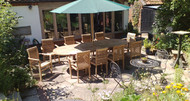Choosing sustainable teak garden furniture involves looking beyond just aesthetics and considering the environmental and ethical impact of your purchase.
Posted by John on 3rd Jul 2025
Here are the key factors to consider:
Certifications (The Most Crucial Factor)
This is your primary assurance that the teak has been sourced responsibly. Look for:
* SVLK (Sistem Verificasi Legalitas Kayu) / INDO-TLAS: This is Indonesia's mandatory national timber legality and sustainability certification system. If the furniture is from Indonesia (which is highly likely for sustainable teak), this is a fundamental certification to look for. It verifies that the timber has been harvested, processed, and exported legally.
FLEGT (Forest Law Enforcement, Governance and Trade) License: Indonesia was the first country to issue FLEGT licenses for timber products to the European Union. A FLEGT license indicates that the timber fully complies with the EU Timber Regulation (EUTR), meaning it's legally harvested and imported.
FSC (Forest Stewardship Council) Certification: While less common for large-scale Indonesian plantation teak compared to SVLK/FLEGT, FSC is a globally recognized certification. It ensures that the wood comes from forests managed in an environmentally appropriate, socially beneficial, and economically viable manner. If you see FSC, it's a very strong indicator of sustainability.
Why they matter: These certifications provide traceability and accountability, ensuring that forests are managed responsibly, local communities are supported, and illegal logging is prevented.
Grade of Teak
Teak is graded based on its quality, which directly impacts durability and appearance. For outdoor furniture, Grade A teak is the gold standard for sustainability and longevity.
Grade A Teak:
- Source: Comes from the heartwood (the very center) of fully mature teak trees (typically 20+ years old).
- Characteristics: Rich in natural oils and rubber, giving it exceptional resistance to water, rot, pests, and weathering. It has a uniform, rich golden-brown color, a tight, even grain, and a smooth, almost waxy feel. Few to no knots.
- Durability: Can last for decades outdoors with minimal maintenance, naturally weathering to a silvery-grey patina. This longevity makes it highly sustainable as it reduces the need for frequent replacement.
- Cost: Most expensive due to its superior quality and the maturity of the wood.
Grade B Teak:
- Source: From the outer heartwood of the tree.
- Characteristics: Lighter in color, less consistent grain, and slightly lower oil content than Grade A. May have some knots.
- Durability: Still good for outdoor use but less resilient and long-lasting than Grade A. May require more maintenance to maintain its appearance.
Grade C Teak:
- Source: From the outer sapwood (the newest part of the tree).
- Characteristics: Very light color, often uneven grain, and almost no natural oils. Prone to splitting, cracking, and water damage. Often treated with stains or sealants to mimic higher grades.
- Durability: Not recommended for outdoor furniture as it has very poor weather resistance and a significantly shorter lifespan. Avoid this if you want sustainable furniture that lasts.
- Why it matters: Choosing Grade A teak is a sustainable choice because its extreme durability means you buy furniture less often, reducing resource consumption and waste in the long run.
Type of Teak (Plantation vs. Reclaimed)
- Both can be sustainable, but they have different characteristics:
- Plantation Teak (most common for new furniture):
- Source: Grown in managed, sustainable plantations (e.g., in Indonesia, often by Perum Perhutani).
- * Sustainability: When certified (SVLK, FLEGT, FSC), it's highly sustainable due to controlled harvesting, replanting, and community involvement.
- Appearance: More uniform in appearance, consistent color and grain.
Reclaimed Teak
- Source: Salvaged from old buildings, boats, bridges, or other structures.
- Sustainability: Excellent from a "reduce, reuse, recycle" perspective, as it gives old wood a new life and no new trees are cut.
- * Appearance: Often has a unique, weathered look with natural imperfections, filler pieces, and a rich patina that tells a story. Can be highly desirable for its character.
Availability: Supply can be inconsistent and limited compared to plantation teak.Why they matter: Both avoid deforestation, but reclaimed teak has a unique aesthetic and truly repurposes existing materials.
Construction and Craftsmanship
- Joinery: Look for traditional joinery methods like mortise and tenon joints secured with wooden dowels. This indicates a high-quality, durable construction that will withstand movement and stress over time without relying on excessive metal screws (which can corrode outdoors).
- Thickness of Wood: Thicker components (e.g., 40mm tabletops, robust legs) generally signify better quality and durability.
Finishing: A smooth, sanded finish shows attention to detail. Some manufacturers may apply a light sealant, but avoid heavy stains or varnishes that might conceal lower-grade wood.
Why it matters: Well-constructed furniture lasts longer, further contributing to its sustainability by extending its lifespan and reducing the need for replacement.
Supplier Reputation and Transparency
- Clear Sourcing Information: Reputable companies will openly state where their teak comes from (e.g., "certified Indonesian plantations") and provide details on their sustainability certifications.
- Customer Reviews: Check independent reviews to gauge customer satisfaction with the quality, durability, and customer service.
- Warranty: A good warranty indicates the manufacturer's confidence in their product's longevity.
Why it matters: A transparent and ethical supplier ensures you're getting what you pay for and that their sustainability claims are legitimate.

